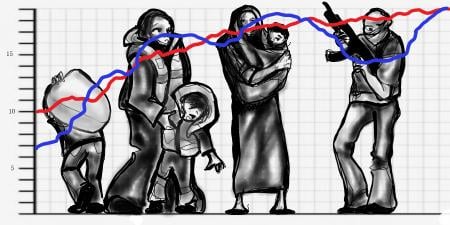Abstract
Military clinicians face unique ethical challenges in conflict zones, particularly if conflict reaches a health care setting. Although the ethical challenges of rationing and triaging while fulfilling obligations to individual patients are not dissimilar to those civilian clinicians encountered during the COVID-19 pandemic, military clinicians must also meet national security and mission requirements. Conflicting clinical care, mission, and individual conscience obligations can cause moral distress, a deeply troubling internal conflict also experienced by civilian clinicians. Crisis settings imposed in conflict or during pandemic surges demonstrate the need for all clinicians to be prepared to modify practice priorities during extreme circumstances.
Case
Dr M is an active-duty internist in a military medical center in Eastern Europe. The hospital treats active-duty and retired military service members and their families. The hospital also treats civilians in the emergency department and transfers them once they are stable. Recently, her country’s military has been in conflict with an aggressive militant group.
Today, the cell phones of the staff and patients buzz with a text alert sent from the country’s emergency warning system, stating there are ballistic missiles coming toward their area and to seek shelter immediately. Dr M notices several of her colleagues rushing out of the hospital in attempts to reach their loved ones. She instead works to rally her floor staff to keep their focus trained on their patients to keep them stable and protect them from any impending blasts.
Meanwhile, the hospital responds in different ways simultaneously. There is a sturdy basement level where many of the laboring mothers, neonatal intensive care unit (ICU) babies, and pediatric ICU children are being transported. Arguments erupt in the emergency department regarding the prioritization of active-duty personnel over families and civilians. Becoming increasingly agitated, the patients on Dr M’s floor question the decision that leaves them on the upper floors.
One hour passes, and nothing happens. Authorities later clarify that the text alert was a false alarm and was never meant to be sent. Dr M feels guilty for not trying to reach her husband and children.
Commentary
Military medical professionals face unique ethical challenges in conflict zones. Many are trained to treat service members and civilians according to certain priorities and rules of engagement (ie, orders governing service member actions), but these guidelines cannot cover the full spectrum of ethically difficult scenarios. One such challenge is when conflict zones reach the hospital. The described case is reminiscent of an actual incident in January 2018 in Hawaii when an alert was sent to residents’ cellphones directing them to seek immediate shelter from an imminent ballistic missile attack.1 The alert forced both civilian and military hospitals on the islands to take the alert seriously and respond. It raised an important question: What if this alert had been real?
Military clinicians have, in addition to their care obligations, duties to country.
Similarly, the COVID-19 pandemic has created traumatic circumstances in health care facilities, resulting in part from the necessity to transition to a crisis standard of care in many civilian hospitals. For example, these facilities experienced difficulties triaging patients due to overfilled ICUs, pediatricians and subspecialists being forced into staffing ICUs, and challenging decisions about distributions of scarce resources (eg, ventilators, medications). What these facilities faced resembles what military clinicians must consider, particularly in conflict zones, where difficult triaging decisions and resource shortages are common. These parallel circumstances of hospital conflict zones and COVID-19 pandemic surges demand that both military and civilian health care professionals be trained to address crises and moral distress resulting from decision making that may defy typical practice or ideal care contexts. However, whereas military physicians receive training for events such as these, most civilian clinicians do not, leaving them relatively unprepared for the ethical challenges the COVID-19 pandemic has presented. This article explores ethical challenges that military health care workers face during conflict and compares conflict contexts in military health facilities with how COVID-19 challenged civilian hospitals and clinicians.
Conflicting Obligations During Crises
Physicians have a duty to care for their patients and to serve their best interests. This professional responsibility derives from the specialized knowledge physicians possess, trust in the physician-patient relationship, vulnerability conferred by illness, and the power imbalance between physicians and patients.2 After assuming the role of providing doctor and taking a patient into their care, the physician will presumably put the welfare of the patient first.3 This is done in small ways all the time. For example, when a surgeon is in the operating room, the surgical case is the only event that matters. If the operation takes longer than expected, there is no other consideration but to carry on uninterrupted, as if there were no life outside the operating room.
In the hospital missile case, the physicians’ commitment to prioritize the care of patients above their own interests is pushed to an extreme. The duty to care prevents Dr M from seeing her family in what might have been a catastrophic event. Dr M is no longer only missing dinner with her family because a particular patient is critically ill and requires additional time; she is being asked to put her profession and patients over her family. Health care professionals like Dr M in the scenario described, who are compelled by their duty to care for and manage patients, give themselves in exchange for the “greater good.” The challenges raised here echo those faced by the countless health care professionals who worked in hospitals during the height of the COVID-19 pandemic, particularly early on when little was known about the virus’ transmission, there were no definitive preventive or treatment pharmaceuticals, and the mortality rate was accelerating. However, military medical professionals have, in addition to their medical obligations, a duty to fulfill their oaths to their country. They feel not only an urge to pursue the greater good by caring for their patients but also a call to support their fellow service members, the country, and its citizens.
Military Clinicians’ Preparation for Crises
Military clinicians may be better equipped to handle ethically challenging crisis events, such as mass casualty scenarios or COVID-19 pandemic surges, than their civilian peers. Often, military clinicians are tasked with preparing for similar contingencies: how to triage one’s own service members in comparison to ally and enemy forces and how to prepare for foreign attacks, domestic terrorism, active shooters, or natural disasters. It is notable that military medical personnel and mobile care sites were deployed throughout the United States in areas that were particularly ravaged by COVID-19 to assist in pandemic response efforts.4 Military medical clinicians receive practical training in mass casualty events and must both mentally and practically prepare for the aforementioned scenarios, in contrast to civilian clinicians, who are often forced to respond reactively. Preparedness for disasters also offers a lesson in building moral resilience (ie, the ability to handle ethically adverse scenarios).
Many guidelines have been produced for addressing disasters such as missile attacks.5,6,7 It is clear from these guides that, as with COVID-19, triage of medical care during disasters emphasizes a utilitarian approach, ie, attempting to save the greatest number by focusing first on those who are most likely to survive with interventions. In the military medical environment, such prioritization assumes a broader scope in that military treatment facilities (MTFs) must, in addition to considering those in greatest need of medical care and those most likely to be saved, value the military mission’s readiness and defense of its nation. This means that active-duty service members may receive special priority for care in MTFs, sometimes superseding the care of other eligible patients. For example, Department of Defense Instruction 6200.03, “Public Health Emergency Management (PHEM) Within the DoD,” Section 5.2, states:
Supporting the Mission. Under emergency conditions, the allocation of resources may not be based solely on medical necessity or risk, but also may be based on operational or other national security requirements, as directed by the President or Secretary of Defense. Some service members, for example, may receive a higher level of care due to operational requirements, independent of their immediate medical risk.8
In military medical environments, a utilitarian ethic is often necessary to protect the unit, maintain security, and advance the mission. Prioritizing treatment of service members in emergency and conflict scenarios is required to return them to duty quickly for maintenance of order and defense of their nation. If civilians know an MTF is nearby in a crisis scenario, they may preferentially seek emergency treatment (which can be offered for nonbeneficiaries on a space-available basis), but those patients might not understand military prioritization practices in such circumstances. Thus, after a missile attack, an MTF might place military clinicians in the difficult position of prioritizing caring for service members over civilians who may require more medically acute attention. Any prioritization that puts seriously injured patients at risk of being denied care may cause moral distress for many clinicians,9 some of whom may be reluctant to remove a patient from needed lifesaving equipment to instead turn their attention to another, less injured patient only because they wear a uniform. Since it is impossible to prepare for every scenario that might occur, it is important to instead focus on developing the individual and team tools needed to address such morally distressing situations before a crisis occurs. These tools include leadership and ethical training, communication with and between staff, and contingencies for disasters so that clinicians are better prepared when confronted by such challenging situations. Developing and strengthening moral resilience is one such method that might benefit both military and civilian health care professionals in this capacity.10
Conclusions
These and other ethical quandaries in times of acute mass disaster, such as a missile attack, deserve consideration. It is critical that military medical and civilian clinicians alike be equipped to handle ethically strenuous situations such as these. Conflict-based scenarios also offer important practical and ethical lessons for civilian hospitals and health care workers regarding emergency preparedness and building moral resilience.
References
-
Nagourney A, Sanger DE, Barr J. Hawaii panics after alert about incoming missile is sent in error. New York Times. January 13, 2018. Accessed July 26, 2021. https://www.nytimes.com/2018/01/13/us/hawaii-missile.html
-
Sulmasy LS, Bledsoe TA; ACP Ethics, Professionalism and Human Rights Committee. American College of Physicians Ethics Manual: seventh edition. Ann Intern Med. 2019;170(2)(suppl):S1-S32.
- Pellegrino ED, Relman AS. Professional medical associations: ethical and practical guidelines. JAMA. 1999;282(10):984-986.
-
Coronavirus: timeline. US Department of Defense. Updated March 29, 2022. Accessed April 6, 2022. https://www.defense.gov/Spotlights/Coronavirus-DOD-Response/Timeline/
-
Health Systems Research, Inc. Altered standards of care in mass casualty events. AHRQ publication 05-0043. Agency for Healthcare Research and Quality; 2005. Accessed January 24, 2022. https://www.hsdl.org/?view&did=453728
-
Center for Preparedness and Response. Public Health Emergency Preparedness and Response Capabilities: National Standards for State, Local, Tribal, and Territorial Public Health. Centers for Disease Control and Prevention; 2018. Accessed January 24, 2022. https://www.cdc.gov/cpr/readiness/00_docs/CDC_PreparednesResponseCapabilities_October2018_Final_508.pdf
-
Federal Emergency Management Agency. Managing the Emergency Consequences of Terrorist Incidents: Interim Planning Guide for State and Local Governments. July 2002. Accessed January 24, 2022. https://www.fema.gov/pdf/plan/managingemerconseq.pdf
-
Office of the Under Secretary of Defense for Personnel and Readiness. DoD instruction 6200.03: public health emergency management (PHEM) within the DoD. US Department of Defense; 2019. Accessed April 6, 2022. https://www.esd.whs.mil/Portals/54/Documents/DD/issuances/dodi/620003p.pdf
- Rushton CH. Defining and addressing moral distress: tools for critical care nursing leaders. AACN Adv Crit Care. 2006;17(2):161-168.
- Rushton CH. Moral resilience: a capacity for navigating moral distress in critical care. AACN Adv Crit Care. 2016;27(1):111-119.



